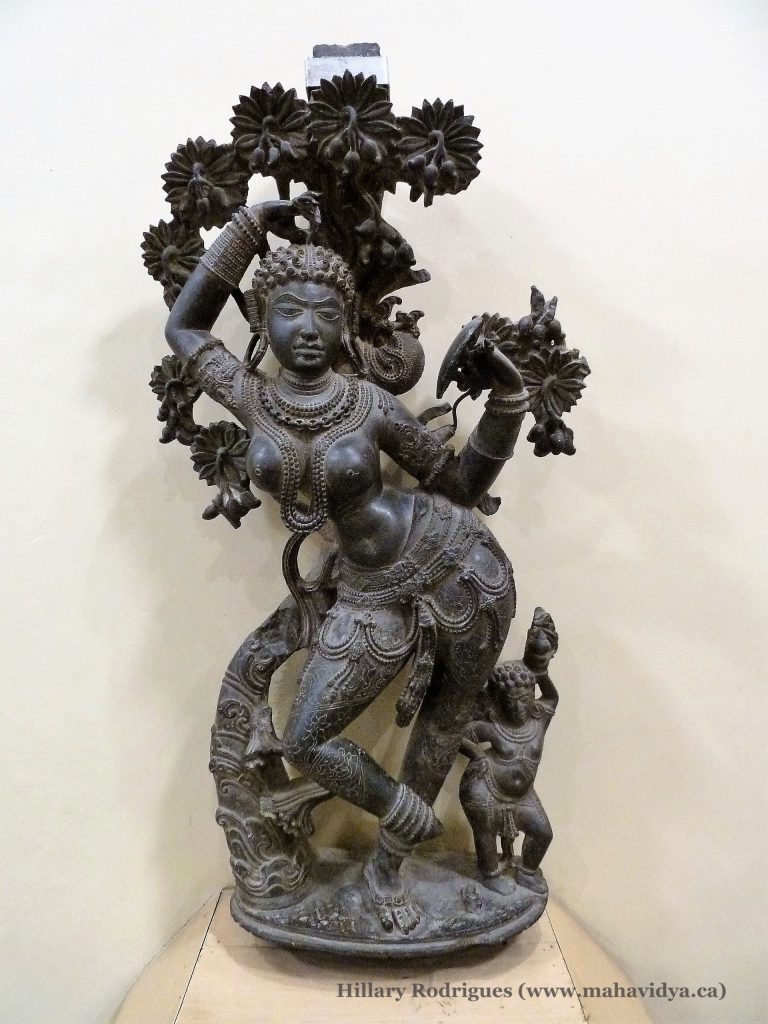Mohini is a manifestation of Visnu in the myth of the churning of the ocean of milk. The myth starts out with a war between the devas (representation of good) and the asuras (representation of bad), but the devas were losing due to an unfair advantage on the asuras’ side (Glucklich 158). The asuras got help from Siva who had given them the ability to resurrect from the dead after the devas had killed them (Glucklich 158). Because of this, the devas sought after Brahma to help them. He suggested that instead of fighting with the asuras they should partner up with them to summon Visnu to help them churn the ocean of milk in order to gain “the nectar of immortality” (Glucklich 158). Visnu plays a vital role in this myth because he manifests in many forms to help the devas and the asuras to churn the ocean. Visnu takes on forms to be: the foundation for the churning stick (a tortoise), the churning rope (a serpent), and of course Mohini (Kinsley 67).

While the ocean was churning, various other things emerge before the nectar of immortality. Once it appeared out of the ocean the devas drank, which is when Mohini appears as a seductive woman who distributes the nectar and beheads Rahu, an asura disguised as a deva, before he can swallow the nectar (Glucklich 159-160). With the nectar and Visnu’s weapons, the devas defeat the asuras as they retreated (Glucklich 160). Some believe that the nectar of immortality was a euphemism for Soma (Glucklich 160) while others interpret it as a “representation of the abundance of earth” (Kinsley 68). This shift between sexes often has bad or negative connotations in religious myths. Normally, when a god, or anyone for that matter, is turned into a different sex (usually men turning into women) it is form of punishment or a curse, with the exception of Mohini (Parasher-Sen 45). Earlier versions of the myth were short and did not use Mohini’s name but rather spoke of an anonymous woman (Visnu in disguise) who took back the immortality nectar that the asuras had stolen (Parasher-Sen 48). A different rendering of this myth believe that Mohini’s role was to cheat the asuras out of their share while distributing the immortality nectar (see Parasher-Sen 48). In the Vayu Purana version of the myth, Brahma says a mantra that brings Mohini out of the ocean, and when he sees her he is so pleased by her looks (Parasher-Sen 48).
Part of the churning the ocean myth is the chase of Mohini by Siva. There are several versions of this part of the myth. In the Bhagavata Purana, after seeing Mohini, Siva loses his senses and runs after Mohini. He becomes so overwhelmed with passion that only after he ejaculates, he realizes that Mohini is really just a manifestation of Visnu and that he had been fooled (Parasher-Sen 48). In the Agni Purana once Mohini turns back into Visnu, Siva asks him to turn back into his female form. When he does, Siva becomes naked and grabs Mohini by the hair until she frees herself and runs away. He follows her and it is unclear if he catches her again but whereever his semen drops is where sacred places of lingas and gold appear (Parasher-Sen 48). These ‘connections’ between Mohini (Visnu) and Siva was said to have created a child (Aiyanar) which turns Mohini into a mother figure instead of a temptress (Parasher-Sen 49).
The final part of the myth is the binding of Visnu and Siva which creates Harihara. Harihara is an androgynous figure which is created by Visnu who is often, but not always, composed as feminine and Siva who is always depicted as masculine (Parasher-Sen 45). Even though Visnu reverts back to his masculine form before the binding with Siva, he is still considered to be the feminine side (Parasher-Sen 45). Although the Harihara is described as being androgynous, with Visnu possessing the female body parts, it is rare to find a depiction of this (Parasher-Sen 51). It is hard to find sculptures of Harihara with Mohini on the side of Visnu, although there are instances of this representation (Parasher-Sen 51). The feminine side (Visnu/Mohini) is often depicted holding either a wheel, a conch, or a mace in one hand and a crab in the other, while wearing a crown and crocodile earrings (Parasher-Sen 51). While the masculine side (Siva) is often holding a trident, sword, drum, rosary, battle-axe, or a skull while wearing serpent earrings and a ‘top-knot of hair’ with a crescent moon (Parasher-Sen 51).
Mohini can be considered many things: the seducer of Siva (Parasher-Sen 46), the nectar distributor (Parasher-Sen 48; Glucklich 159-160; and Kinsley 67), the mother of Aiyanar (Parasher-Sen 49), and the deceiver of asuras (Parasher-Sen 46). Some scholars think that Mohini is important to the Hindu culture because she helps show women in a more positive light, and that the transformation from a male to female is not always a curse but rather a gift (Parasher-Sen 56), and in the case of Mohini, a necessity to stop the bad from becoming more powerful than the good.
REFERENCES AND RELATED READINGS
Glucklich, Ariel (2008) The Strides of Visnu. New York: Oxford University Press.
Kinsley, David R. (1986) Hindu Goddesses. Berkeley: University of California Press.
Parasher-Sen, Aloka (1999) “Images of Feminine Identity in Hindu Mythology and Art: The Case of Visnu-Mohini.” Indian Journal of Gender Studies, Vol. 6, No. 1: 43-60.
RELATED TOPICS
Visnu
Siva
Asuras
Devas
Vayu Purana
Immortality
Bhagavata Purana
Agni Purana
Androgynous
War
Seduction
Sculpture/Art Work
Aiyanar
RELATED WEBSITES
http://www.qualiafolk.com/2011/12/08/mohini/
http://hinduwebsite.com/churning.asp
https://en.wikipedia.org/wiki/Kshir_Sagar
https://en.wikipedia.org/wiki/Mohini
Article written by: Michaela Klein (February 2016) who is solely responsible for its content.
